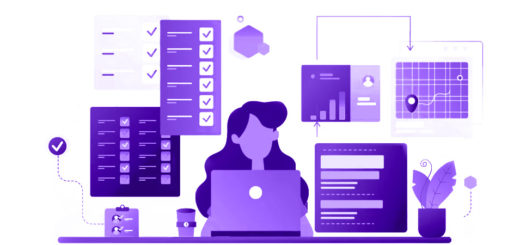The Relationship Between Project Management And Risk Management

When managing a project, some of the key expectations will be to remain on schedule, within budget, and in line with company expectations. Meeting these goals sounds easier than it actually is, and risks can further complicate the progress of both simple and complicated tasks. This is why any responsible project manager will prioritize risk management.
By understanding the threats facing your project, you can plan in advance to mitigate damages while remaining on track with your larger goals. Risk management involves identifying, analyzing, and responding to threats that may affect your project. Therefore, managing risk should be a critical part of project planning. By thinking about what could possibly go wrong, you’ll be better prepared to respond to risk without derailing the entire project.
A primary challenge that project managers face is how to smoothly incorporate risk management into their daily workflows. Indeed, limited resources and tight schedules might tempt you to overlook risks, which is why understanding the relationship between project management and risk management is critical. While project management focuses on defining a goal and implementing steps to achieve that goal, risk management involves identifying and mitigating threats that may affect progress. These two processes work hand in hand to ensure that you deliver timely and quality projects for your organization.
An Overview Of Project Management
Project management can be defined as the process of coordinating efforts and resources to create a unique product/service. Projects are planned so as to achieve specific goals, and they often involve special teams working together on a temporary basis. Furthermore, projects may involve the allocation of additional resources to help the company meet its goals.
Because many projects involve workflows that are outside the scope of your daily operations, developing a plan for managing risk is critical. Every project will come with a unique set of risks that may prevent progress. Thinking and planning ahead will help you understand your risk environment better so you can respond appropriately when a threat occurs.

What Is Risk Management?
Risk management is the process of identifying, analyzing, and responding to threats that may affect the success of your project. Because each project is carried out under a unique set of circumstances, risk management should be an essential component of project planning. Understanding your risk environment should be part of the larger planning process, and appropriate personnel should be assigned to perform these tasks. Furthermore, every stakeholder in the project has a role to play when it comes to risk management.
The definition of risk can be broad. It is generally any event that could derail the progress of your workflows, ranging from cybersecurity threats to delayed timelines.
Because of the expansive nature of risks, every project manager should take time to analyze their risk environment in detail. A risk can be measured by multiplying the likelihood of an event by its impact. Using this approach allows you to categorize different levels of risk while paying attention to those that could cause the most damage. Other types of risk may be low impact or have a low likelihood of occurrence. In such cases, it makes sense to accept the risk and take no specific mitigative actions. As long as you can keep risks as potentialities that won’t turn into realities, your project is likely to go smoothly and meet its goals.
Risk Management in Projects
Proper risk management is a critical component of the larger project management phase. Risk and project management work hand in hand to help you deliver timely, quality, and reliable results during every project. However, one thing that many project managers struggle with is incorporating risk management into project management. How can you ensure that all stages of the project are being carried out with recognition of your risk environment?
The best approach to take as a project manager is involving all stakeholders during the early stages. You can do this by planning risk assessment meetings, where you involve all team members in crafting a detailed plan for identifying, analyzing, assessing, and mitigating risks. In cases where your organization doesn’t have a framework for risk management during projects, you may need to raise awareness about this process to the management team. Organizational leaders play a critical role in helping plan and facilitate risk management tasks. Not only can they incorporate risk analysis into the corporate policy, but they can also set a proper tone for stakeholders to prioritize risk management during every step of the process.
Risk management can also be carried out with the help of technology. Using project management tools, you can create Gantt charts for identifying and assessing risks during different stages. Kanban boards are also excellent resources for managing risks and prioritizing threats that may potentially cause the most damage.
Steps for Managing Risk during Projects
By now, many project managers know just how important risk management in projects can be. Risk management is also a critical part of the project planning phase, and the two procedures work hand in hand to help you meet organizational goals without going over budget or causing delays. Technology has also made risk management a much more efficient process. You can take advantage of computing power and various tools to better understand your risk environment and mitigate significant threats before they occur.
However, simply having these tools isn’t enough to help you carry out a successful project. You also need to know how to best use resources in a manner that helps manage your risk environment. Here are specific steps you can take when managing risk during projects.

#1. Make risk management an essential part of the project
Making risk management part of the entire project framework is critical towards meeting your goals. You can do this by hiring professionals who have expertise and experience in managing potential threats. Such personnel not only help you prepare realistic and detailed plans, but they can also train internal team members on how to detect risks during early stages.
You can embed risk management into project planning by exploring many different risk identification techniques. A trial and error process is sometimes necessary to find the best way of identifying and analyzing risks in line with project goals. You may also explore risk identification methods that best leverage current technologies such as artificial intelligence and project management tools. For example, IT-related risks typically occur during the development, execution, or integration phases. By categorizing potential risks into these groups, you can optimize the risk identification process.
#2. Develop a risk communication plan
After putting in place robust risk identification and analysis measures, the next step is to develop a communication plan. Risk communication allows the entire team to find out what’s happening as soon as a potential risk is identified. Furthermore, effective communication streamlines the risk management process because you can coordinate efforts more efficiently, even during large complicated projects.
The best way of establishing an effective communication plan is by making it easier for employees to report risks while working on specific tasks. A clear communication channel should be embedded into daily workflows so that potential threats can be identified (and responded to) faster. Furthermore, the communication channel should include details such as the type of risk, its potential impact, and possible mitigation steps. Project managers also have the responsibility of creating a comfortable environment where team members can report risks without feeling stigmatized.
#3. Have criteria for prioritizing risk
In addition to risk reporting and timely communication, you also need a framework for prioritizing risk. Not all threats will have the same impact on your project. For example, some are low impact risks that may derail your goals but can be reasonably managed. Others are high degree, high impact risks that could potentially affect entire outcomes. By having a plan for prioritizing risk, you can allocate resources accordingly to ensure that your project isn’t affected. There are many frameworks you can use to prioritize risks.
Start by asking yourself whether the risk could impact your company, its customers, or other stakeholders. You can also determine the level of importance your project has to overall company goals. Will the risk impact multiple stakeholders and cause significant setbacks? In the IT space, you can also categorize risks into specific groups that make prioritization easier.
For example, launching a new software may necessitate risk categorization into the following groups: control, functionality, system architecture, and performance risks. These groupings streamline the process and enable you to follow a more thorough path when identifying and prioritizing risks.
#4. Analyze your risk environment
Any experienced project manager will tell you that simply identifying and categorizing risks isn’t enough to ensure the success of your project. You’ll need to go a bit deeper by analyzing each risk and determining its potential effects on current or future workflows. Risk analysis is a multidimensional process that involves many different stakeholders. It involves determining the likelihood of occurrence, impact, and mitigation steps that may be necessary. During the risk analysis process, make sure you consider the following elements:
- Risk probability
- Risk impact
- Risk categorization
- Risk location (which parts of the project is the threat likely to affect?)
#5. Develop a risk response plan
While the above steps are a critical part of risk management, the process won’t be complete if you don’t have a risk response plan. Risk response refers to the actual steps that you’ll take to mitigate risks and ensure the success of your project. There are generally 4 procedures that are involved when implementing a risk response plan: risk acceptance, avoiding, transferring, or mitigating. A risk can be accepted if its effect on the project will be negligible. This means understanding that such threats are likely to happen and carrying out the project in recognition of those risks.
You may also choose to avoid a risk entirely. With this response, you will essentially plan and implement the project in a manner that you avoid coming across the risk. The third response, transferring, occurs when the risk cannot be realistically avoided. The risk is thereby transferred to another party, such as an insurance company. In exchange for premiums, insurers accept certain types of risk and provide coverage/compensation in the event that those risks were to occur. The fourth response, mitigation, refers to minimizing the effects of potential risk on your project. This means understanding all potential causes or factors that surround this risk and developing compensatory mechanisms to minimize project disruption.
The actionable steps described above will form the basis of your risk response plan. You can see how, by understanding your risk environment, you can develop more effective responses to ensure that your project runs smoothly.
#6. Regular reporting
After the development of a risk response plan, it helps to follow up on the process and determine how effective your actions actually are. This can be done via continuous reporting, where you regularly track risk occurrence and the type of response that was implemented. Was this response effective? Is your project still on course for completion? What could have been done better?
These questions can be answered by keeping detailed records of the risk management process and how it influenced the success of your project. Furthermore, such insights can be used during future projects so as to improve on your risk response techniques.

Source: giphy.com
How Project Managers Can Assist With Risk Management Tasks
Because risk management is an essential part of any project, project managers have a big role to play when identifying, analyzing, and mitigating risks. Indeed, all stakeholders will rely on the expertise of the project manager to help during the planning, execution, and completion of the project.
The good news is that many skills that are required during project management also apply to manage risks on a daily basis. Here are critical tasks that all project managers should carry out during the risk management process.
#1. Providing leadership during the planning stage
While planning is an all-inclusive process where many different people will be involved during decision-making, project managers should take the leadership role. They are responsible for charting the most realistic and efficient channels through which the project will be carried out. More specifically, project managers should be at the forefront of deciding project scope, timelines, and resource allocation. They may also make recommendations as to the best tools necessary to achieve critical project goals.
#2. Assembling relevant teams and assigning appropriate tasks
Project managers also play an important role during talent identification. In addition to having the right personnel for the job, you will also need to determine which personalities work best towards a specific goal. Assembling effective teams can be the difference between efficient, underbudget projects and conflict-ridden workflows that derail progress. Furthermore, proper team assignment makes communication easier while streamlining the risk identification process.
#3. Resource management
Project managers should have the final say with regard to resource allocation. While you don’t need to oversee every transaction, keeping expenses within budget and ensuring that resources are being used correctly will be an important responsibility. Proper resource management can help you mitigate budget-related risks, including project delays, as a result of limited resources or wastage.
#4. Record generation and record-keeping
Accurate record-keeping is the key to implementing a successful project. This is because you can document all relevant workflows, including risks that you may have faced during the execution of a project. Records are also a valuable resource that you can rely on to improve future tasks and implement more efficient projects. Project managers should set the proper tone for record-keeping by overseeing the process, correcting mistakes along the way, and using feedback from reports to implement relevant changes.
Project management involves coordinating many different components that come together to help the company meet its goals. By applying relevant skills and techniques while paying attention to risk management best practices, a project manager can successfully propel their project from the initiation stage to closing.














